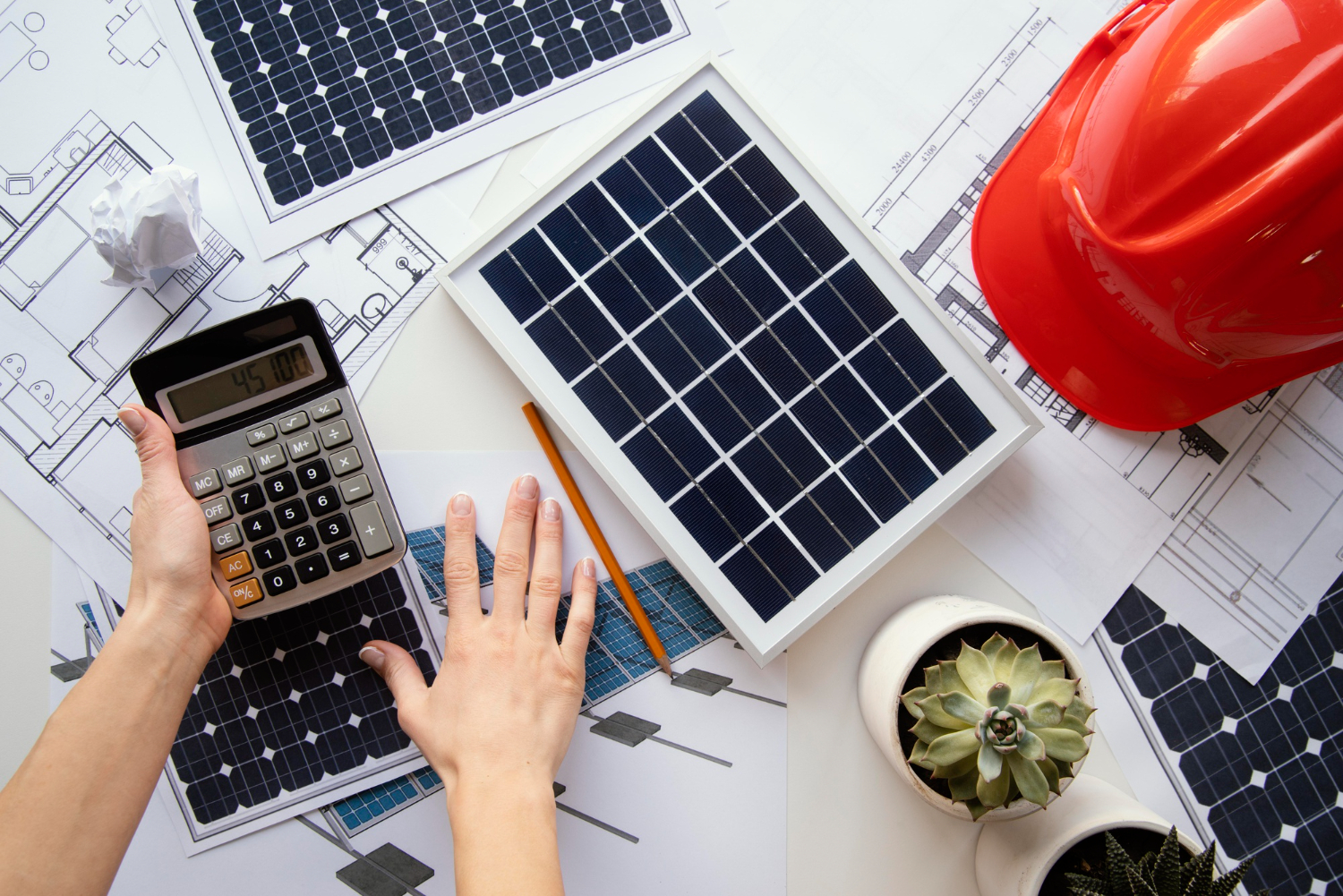Are you thinking about installing solar panels at your home or office,but you are confused about the approximate cost? Don’t fear—you’re not alone. With load-shedding getting worse and energy payments going better each month, an increasing number of people in Pakistan are turning to solar energy. It’s a smart way to save money and enjoy uninterrupted electricity. But before you decide, it’s important to understand how much it costs. In this guide, you’ll learn about types of solar panels, top brands,per-watt prices, and complete installation cost, so you can make a better decision.
Table of Contents
What are the Benefits of Choosing Solar in Pakistan?
Pakistan is one of the sunniest countries in the world. Most areas get around 8–10 hours of sunlight per day, which makes solar energy highly effective and affordable in the long run.
Here are the top reasons people are installing solar systems:
- Lower power bills: Installing solar panels allows you to to reduce your month-to-month electricity payments by producing your own power from daylight.
- Backup at some point of load-shedding: Solar structures, in particular with batteries, offer backup power all through load-dropping and strength outages.
- Environment-friendly: Solar energy is a clean and green supply of strength that enables us to lessen pollutants and defend the environment.
- Good return on investment: Although the preliminary cost is high, solar panels pay for themselves within a few years via financial savings on electricity payments.
- Government internet metering manual: With internet metering, the authorities allow you to sell extra energy back to the grid, similarly lowering your bill and growing savings.
Understanding Solar Panels Price List in Pakistan
The cost of a solar panel depends on
- Type of solar panel (monocrystalline, polycrystalline, bifacial)
- Brand
- Power rating (watts)
- Warranty
- Installation and inverter charges
Let’s now break it down so you can understand easily.
Solar Panel Price per Watt in Pakistan (2025)
Solar panels are usually priced per watt (W). The higher the wattage, the more power it produces. Here is the average price per watt:
| Panel Type | Price Range (Per Watt) | Efficiency |
| Polycrystalline | Rs. 35 – Rs. 45 | Moderate (~16%) |
| Monocrystalline | Rs. 45 – Rs. 60 | High (~20%) |
| Bifacial (Dual Side) | Rs. 55 – Rs. 70 | Very High (20%+) |
Note: These are market average prices as of mid-2025. Prices may vary by city and brand.
Common Solar Panel Sizes & Prices in Pakistan
Here’s a basic list of popular panel sizes and their estimated market prices:
| Solar Panel Size | Type | Average Price (PKR) |
| 150W | Poly | Rs. 5,500 – 6,500 |
| 250W | Poly | Rs. 8,000 – 10,000 |
| 330W | Mono | Rs. 12,000 – 14,500 |
| 400W | Mono/Bifacial | Rs. 15,000 – 18,500 |
| 500W | Mono/Bifacial | Rs. 18,000 – 23,000 |
| 550W | Bifacial (Top Tier) | Rs. 22,000 – 26,000 |
Complete Solar System Cost in Pakistan (With Installation)
Let’s now see the estimated total price if you want to install a full solar panel system at your home.
3kW Solar System (For small homes)
- A 3kW solar panel is ideal for small homes as it may run fans, lights, and 1–2 fundamental home equipment like a TV or small fridge.
- The price variety for this setup is between Rs. 450,000 and Rs. 550,000, depending on the brand and installation setup.
- It supports net metering, so you can sell extra electricity back to the grid and lower bills.
- If you choose a hybrid system with batteries, it can offer backup power for four to six hours during the time of load-shedding.
5kW Solar System (For medium homes)
- A 5kW solar panel system is suitable for medium-sized houses and may without difficulty run lights, fans, fridge, an AC, and a washing machine.
- The overall value for this system normally falls between Rs. 750,000 and Rs. 950,000, depending on the equipment and installer.
- It is compatible with internet metering, so you can store extra by way of promoting more electricity lower back to the grid.
- If hooked up as a hybrid solar panel system with batteries, it may give you backup power for six to eight hours throughout load-shedding.
10kW Solar System (For large homes or offices)
- A 10kW solar panel system is perfect for massive houses or workplaces, as it could run the complete house, which includes a couple of ACs, appliances, and heavy electrical loads.
- The overall price of this solar panel system usually ranges from Rs. 1,300,000 to Rs. 1,700,000, depending upon the quality of components and installation service.
- It is absolutely net metering enabled, permitting you to sell more energy to the grid and reduce your month-to-month bill.
- When established as a hybrid system with batteries, it can offer backup strength for 8 to 10 hours at some point of load-dropping or power outages.
Includes: solar panels, inverter, batteries (if hybrid/off-grid), structure, wiring, and installation.
Top Solar Panel Brands in Pakistan
Here are some reliable solar panel brands available in Pakistan:
| Brand | Country | Popularity | Warranty Offered |
| Longi Solar | China | ★★★★★ | 10–25 years |
| JA Solar | China | ★★★★☆ | 10–25 years |
| Canadian Solar | Canada | ★★★★★ | 10–25 years |
| Jinko Solar | China | ★★★★☆ | 10–25 years |
| Trina Solar | China | ★★★★☆ | 10–25 years |
| Inverex | Pakistan | ★★★★☆ | 5–10 years |
| Tesla Solar | Local | ★★★☆☆ | 5–10 years |
Pro Tip: Always choose Tier-1 panels with certified warranties from trusted sellers.
The Inverter Cost
The solar inverter is the brain of your solar system, it converts DC to AC so your appliances can use the energy.
Here’s the average inverter price list:
| Inverter Capacity | Type | Price Range |
| 3kW | On-Grid | Rs. 90,000 – 120,000 |
| 5kW | Hybrid | Rs. 140,000 – 200,000 |
| 10kW | Hybrid | Rs. 250,000 – 350,000 |
Battery Cost (Optional for Hybrid/Off-Grid)
If you want backup during load-shedding, you’ll need batteries. These add to the overall cost but give peace of mind.
| Battery Type | Price Range (Per Battery) | Life Span |
| Lead Acid | Rs. 25,000 – 35,000 | 2–3 years |
| Dry Battery | Rs. 40,000 – 60,000 | 3–4 years |
| Lithium-ion | Rs. 90,000 – 150,000 | 8–10 years |
Factors That Affect Solar Panel Prices
Here are a few reasons why solar panel prices may go up or down:
- Dollar Rate: Most panels are imported.
- Brand Name: Premium brands cost more.
- Technology: Bifacial and N-type are more expensive.
- Warranty Period: Longer warranty = higher price.
- Installation Area: Difficult rooftops or ground mounts may increase labor cost.
Is It Worth It? Return on Investment
Yes, it is! A properly installed solar system can recover its full cost in 3 to 5 years, after which you enjoy free electricity for 20+ years.
With net metering, your electricity bill can go down to zero, and you may even earn from excess energy exported back to the grid.
Tips for Buying Solar Panels in Pakistan
Here are expert tips to get the best value:
- Get quotes from multiple companies—compare before you buy.
- Check warranty and efficiency—Don’t fall for fake offers.
- Choose the right system size—based on your monthly electricity usage.
- Always go for certified installers—avoid risks of faulty wiring or breakdowns.
- Ask for net metering registration—it adds long-term value.
How much electricity a solar panel can generate
Conclusion: Invest Smart, Live Bright
Switching to solar is no longer just a trend, it’s a smart decision. With high electricity prices in Pakistan, solar energy offers long-term savings and energy independence.
Before investing, always study the latest solar panel price list, compare brands, and select a trusted installer. Whether you want a 3kW system or a large 10kW hybrid setup, solar can give you control over your bills and contribute to a greener Pakistan.
FAQ: Solar Panel Price in Pakistan
Q1: What is internet metering, and how does it assist?
Net metering permits you to promote more electricity returned to Electricity generating companies, which could lessen or maybe eliminate your bill.
Q2: Can I run AC on solar panels?
Yes, if your system is 3 kW or higher, you can run 1 or extra ACs, depending on your general system load and usage.
Q3: Are solar panels water-resistant?
Yes, solar panels are absolutely water resistant and designed to deal with rain, dirt, and outside climate.
Q4: How much area is needed for putting in solar panels?
A 1kW system needs around a hundred rectangular feet of shadow-free space. So, a 5kW system requires around 500 rectangular feet.
Q5: Is solar better than the usage of UPS?
Yes, solar is cleaner, cheaper in the end, and offers higher backup with internet metering.


